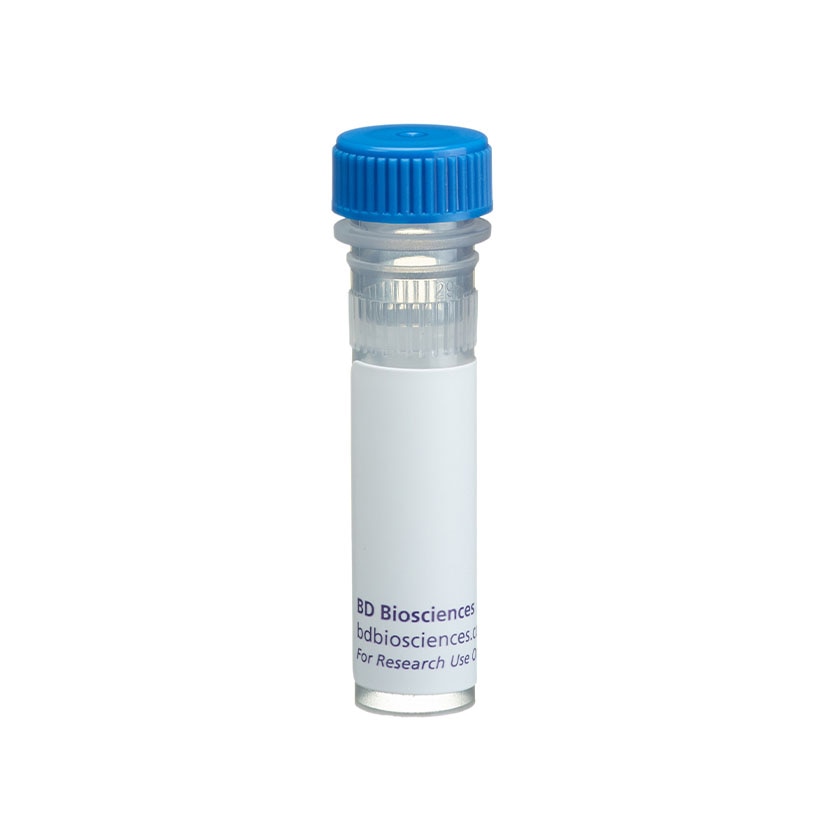Old Browser
This page has been recently translated and is available in French now.
Looks like you're visiting us from {countryName}.
Would you like to stay on the current country site or be switched to your country?




Expression of mouse CD195 by stimulated mouse splenocytes. BALB/c splenocytes were stimulated for 24 hours with ConA (10 µg/ml, final concentration; Sigma). The splenocytes were cultured for additional 5 days in the presence of mouse IL-2 (100 U/ml, final concentration; Cat. No. 550069). The splenocytes were stained with purified rat anti-mouse CD195 antibody (C34- 3448), followed by biotinylated mouse anti-rat IgG2c (A92-1, Cat. No. 553909) and Streptavidin- hycoerythrin (Cat. No. 554061) following BD Pharmingen's staining protocol (see Figure, Left panel). The data reflects gating on lymphocytes, based on forward and side scattered light signals. The level of nonspecific staining was assessed using the purified rat IgG2c isotype control (purified A23-1; Cat. No. 553982; Right panel). The quadrant markers for the bivariate dot plots were set based on the autofluorescence control and isotype control.


BD Pharmingen™ Purified Rat Anti-Mouse CD195

Regulatory Status Legend
Any use of products other than the permitted use without the express written authorization of Becton, Dickinson and Company is strictly prohibited.
Preparation And Storage
Recommended Assay Procedures
Immunofluorescent Staining and Flow Cytometry Analysis: The purified C34-3448 antibody can be used for multicolor immunofluorescent staining and flow cytometric analysis to identify and enumerate CD195-expressing cells within mixed cell populations. For optimal immunofluorescent staining with flow cytometric analysis, the antibody should be titrated (≤0.25 µg mAb/million cells, see Figure above). For specific methodology, please visit the protocols section or chapter on intracellular staining in the Immune Function Handbook, both of which are posted on our web site, www.bdbiosciences.com.
Product Notices
- Since applications vary, each investigator should titrate the reagent to obtain optimal results.
- Please refer to www.bdbiosciences.com/us/s/resources for technical protocols.
- Caution: Sodium azide yields highly toxic hydrazoic acid under acidic conditions. Dilute azide compounds in running water before discarding to avoid accumulation of potentially explosive deposits in plumbing.
The C34-3448 monoclonal antibody specifically binds to CD195 which is also known as, C-C chemokine receptor type 5 (CCR5). CD195 is a seven transmembrane-spanning G-protein-coupled receptor that belongs to the β-chemokine receptor family. CD195 regulates lymphocyte chemotaxis activation and transendothelial migration during inflammation. It signals in response to at least three chemokines: CCL3/MIP-1α, CCL4/MIP-1β, and CCL5/RANTES. CD195 is expressed on macrophages and some T-lymphocytes.
Development References (3)
-
Boring L, Gosling J, Monteclaro FS, Lusis AJ, Tsou CL, Charo IF. Molecular cloning and functional expression of murine JE (monocyte chemoattractant protein 1) and murine macrophage inflammatory protein 1alpha receptors: evidence for two closely linked C-C chemokine receptors on chromosome 9. J Biol Chem. 1996; 271(13):7551-7558. (Biology). View Reference
-
Meyer A, Coyle AJ, Proudfoot AE, Wells TN, Power CA. Cloning and characterization of a novel murine macrophage inflammatory protein-1 alpha receptor. J Biol Chem. 1996; 271(24):14445-14451. (Biology). View Reference
-
Napolitano M, Seamon KB, Leonard WJ. Identification of cell surface receptors for the Act-2 cytokine. J Exp Med. 1990; 172(1):285-289. (Biology). View Reference
Please refer to Support Documents for Quality Certificates
Global - Refer to manufacturer's instructions for use and related User Manuals and Technical data sheets before using this products as described
Comparisons, where applicable, are made against older BD Technology, manual methods or are general performance claims. Comparisons are not made against non-BD technologies, unless otherwise noted.
For Research Use Only. Not for use in diagnostic or therapeutic procedures.
Report a Site Issue
This form is intended to help us improve our website experience. For other support, please visit our Contact Us page.